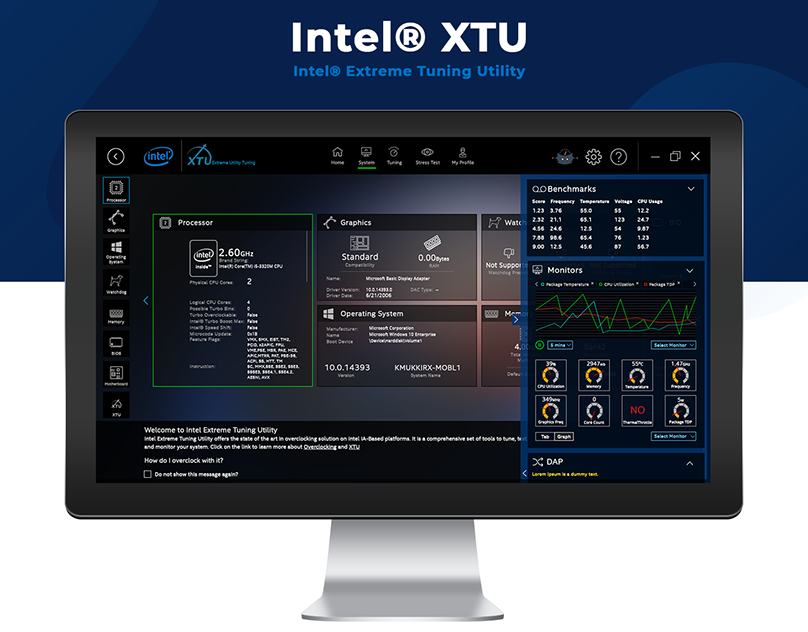Intel Extreme Tuning Utility

System requirements
- Windows 11 (22H2)
- Windows 11 (21H2)
- Windows 10 (22H2)
- Intel Core i9
- Intel Core i7
- Intel Core i5
- Intel Xeon
- It is recommended to use the latest version of Intel XTU for advanced features and to avoid profile incompatibilities.
- Users with older versions of Intel XTU profiles (7.9 and older) may experience incompatibility and will need to contact Intel Support to convert older profiles.
Main features of Intel XTU:
- Performance Monitoring: Allows you to monitor clock speed, temperature, voltage and other key metrics in real time.
- Overclocking: Simple interface to change multipliers and voltages, which can increase the performance of your processor.
- Stability testing: Built-in tests to check system stability after changes are made.
- Settings Profiles: Ability to save and quickly apply different settings configurations.
Determine current CPU performance
It is recommended that you establish a baseline of processor performance before making changes. This will allow you to quantify the power gain achieved as a result of successful overclocking. Intel XTUhas two performance tools – you can use either one. For example, in the “Basic Tuning” tab, you can get performance points by clicking the “Run Benchmark” button.
It is also possible to run a longstress testfrom the application. It is recommended to run it after changing certain parameters in order to observe the processor heating temperature at the specified values.
Adjusting Performance Settings
Beginners are advised to start by changing the multipliers located in the “Basic Tuning” tab. There are only two of them:
- Processor Core Ratio Determines the overall speed of the processor, which is calculated by multiplying the base clock speed by this multiplier.
- Processor Cache Ratio. Determines the operating frequency of CPU components such as the memory controller and cache memory. Setting the cache ratio to a frequency lower than the core ratio may result in poor performance.
When overclocking the user for the first time, it is recommended to maintain approximately the same values of both multipliers, and it is better to adjust them one at a time. But you can experiment. In any case, the multipliers should be increased gradually. After the next adjustment, you need to restart the computer, and then monitor the stability of its operation by running a stress test.
The “Advanced Tuning” tab provides advanced overlocking settings. Here you can change the parameters discussed above for each of the processor cores separately, the voltage supplied to them, and a number of other parameters that you can experiment with.
But the most important thing here is the power settings. As the multipliers increase, the processor will require more voltage for subsequent stable operation. To do this, you should gradually increase the “Core Voltage” and/or “Core Voltage Offset” parameter. You should be extremely careful with your power settings. By the way, they are applied instantly without restarting the PC.
Measuring performance gains and stress testing
After changing parameters, you should first measure the performance gain using the Run Benchmark function. If the result is not satisfactory, we return to overlocking again. If everything is satisfactory, we move on to stress testing. During testing, the program may display the “Fail” error, which will signal the need to change the configuration, but it is up to the user to find out which parameter needs to be lowered or increased.
Possible risks and limitations:
- Warranty: Overclocking may void your processor’s warranty.
- Compatibility: Not all processors support overclocking.
Using Intel XTU you will have complete control over your processor, optimize its performance and even increase the performance of your system. However, you should remember the possible risks and features of this process.
Download the Intel Extreme Tuning Utility
Last update:
New in version 7.13.1.5:
TheIntel Extreme Tuning Utility(Intel XTU) update version7.13.1.5has the following changes and improvements:
Changes:
- XMP Memory Tab:Text fields have been updated to drop-down lists.
- Installer:Removed the requirement to manually elevate installer privileges.
- Max Core Clock Monitor: The maximum core clock monitor has been removed.
- P-Core and E-Core frequency monitors:Added P-Core and E-Core maximum frequency monitors.
- Settings link: Added a settings link that allows the user to open the log folder.
Included drivers:
- IOCBIOS Device Driver 7.12.0.18
- Intel XTU Extension Device 7.12.0.0
- Intel XTU Component Device 7.13.1.5
- Watchdog Device Driver 11.7.0.10 12
Known issues:
- On some system configurations, Virtualization Based Security (VBS) and OS s that include VBS are incompatible with < strong>XTU. In these cases, XTU cannot function when these features are enabled.
- On some system configurations with undervoltage protection, XTU will not be able to set the voltage control to default values.
Supported platforms:
- SkylakeX
- Coffee Lake
- CascadeLakeX
- CometLake
- RocketLake
- TigerLake
- AlderLake
- RaptorLake
- SapphireRapids
Supported operating systems:
- Windows 10 22H2
- Windows 11 21H2
- Windows 11 22H2 SV2
- Windows 11 SV2 October Moment Release
- Windows 11 SV2 February Moment Release
- Windows 11 SV2 May Moment 3 Release